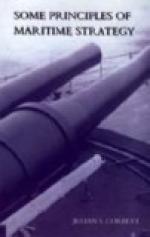In both these forms of blockade it is usual, as a matter of courtesy, to allow neutral armed ships belonging to foreign navies to enter and leave for their own purposes, presumably connected with the subjects of their own country who are in the blockaded port. This, however, is not a right, and the country to which the blockading ships belong has a right to refuse it, and to back her refusal by force.
All countries must be notified of a properly instituted commercial blockade, in accordance with International Agreement.
(3) Observing a Port.—This, with its subsidiary operations, should be conducted in such a way as to induce the enemy to put to sea, the object of observing the port being primarily a naval one, viz., to bring him to decisive action.
The principal observing force (consisting of battleships and cruisers) would be either in one squadron, or more, provided that they were in supporting reach of each other, and so placed as to be able to cut off the enemy’s fleet on emerging from the port observed before it can get dangerously near its probable objective, and yet sufficiently far out to ensure a battle before it can regain the shelter of its own ports. It is also worth noting that the battle should, if possible, be fought so as to make it difficult for the enemy’s damaged ships to obtain the shelter of a friendly neutral’s harbours before being captured.
The observed port must be watched closely, so that immediate notice of the enemy’s exit may be given; and this would be done by small cruisers, scouts and destroyers, which should be strong and numerous enough to attack any torpedo craft trying to get to sea.
In order to induce the enemy’s main force to put to sea it is important that every means be used to prevent his knowing that our fleet is observing the port, or if that be impossible, to do nothing which will lead him to suppose that his port is being observed.
This operation is not a blockade.
Subsidiary operations to induce the enemy’s fleet to put to sea, may take the form of a diversion on the enemy’s coast, or against some important part of his sea-borne trade, either by the observing fleet or by a force affiliated to it, or by any oversea movements calculated to interfere seriously with the enemy’s war plan.
Concentration
The guiding feature of modern preparation for war is to be ready for rapid action. It is true at sea, more even than on land, that upon the first movements depend the initiative, the power of controlling the enemy’s strategy, and of making him conform to our movements. This readiness for rapid action will depend on a proper distribution of the fleet so as to meet all the requirements.
The distribution of the fleet should be dominated by the idea of concentration, but it must be understood clearly what concentration means. Clausewitz says:—“The best strategy is always to be sufficiently strong, at first generally, then at the decisive point. There is therefore no higher or simpler law for strategy than this—keep your forces together.”




